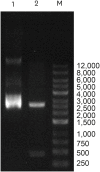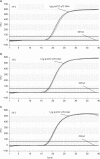Development of a ladder-shape melting temperature isothermal amplification (LMTIA) assay for detection of African swine fever virus (ASFV)
- PMID: 35698807
- PMCID: PMC9346532
- DOI: 10.4142/jvs.22001
Development of a ladder-shape melting temperature isothermal amplification (LMTIA) assay for detection of African swine fever virus (ASFV)
Abstract
Background: Due to the unavailability of an effective vaccine or antiviral drug against the African swine fever virus (ASFV), rapid diagnosis methods are needed to prevent highly contagious African swine fever.
Objectives: The objective of this study was to establish the ladder-shape melting temperature isothermal amplification (LMTIA) assay for the detection of ASFV.
Methods: LMTIA primers were designed with the p72 gene of ASFV as the target, and plasmid pUC57 was used to clone the gene. The LMTIA reaction system was optimized with the plasmid as the positive control, and the performance of the LMTIA assay was compared with that of the commercial real-time polymerase chain reaction (PCR) kit in terms of sensitivity and detection rate using 200 serum samples.
Results: Our results showed that the LMTIA assay could detect the 104 dilution of DNA extracted from the positive reference serum sample, which was the same as that of the commercial real-time PCR kit. The coincidence rate between the two assays was 100%.
Conclusions: The LMTIA assay had high sensitivity, good detection, and simple operation. Thus, it is suitable for facilitating preliminary and cost-effective surveillance for the prevention and control of ASFV.
Keywords: African swine fever (ASF); African swine fever virus (ASFV); commercial real-time PCR kit; ladder-shape melting temperature isothermal amplification (LMTIA).
© 2022 The Korean Society of Veterinary Science.
Conflict of interest statement
The authors declare no conflicts of interest.
Figures






Similar articles
-
Development of a real-time loop-mediated isothermal amplification (LAMP) assay and visual LAMP assay for detection of African swine fever virus (ASFV).J Virol Methods. 2020 Feb;276:113775. doi: 10.1016/j.jviromet.2019.113775. Epub 2019 Nov 11. J Virol Methods. 2020. PMID: 31726114
-
Development of cross-priming amplification for direct detection of the African Swine Fever Virus, in pig and wild boar blood and sera samples.Lett Appl Microbiol. 2016 May;62(5):386-91. doi: 10.1111/lam.12569. Lett Appl Microbiol. 2016. PMID: 27002564
-
Development of a real-time PCR assay for detection of African swine fever virus with an endogenous internal control.Transbound Emerg Dis. 2020 Nov;67(6):2446-2454. doi: 10.1111/tbed.13582. Epub 2020 May 2. Transbound Emerg Dis. 2020. PMID: 32306531
-
Development of a novel quantitative real-time PCR assay with lyophilized powder reagent to detect African swine fever virus in blood samples of domestic pigs in China.Transbound Emerg Dis. 2020 Jan;67(1):284-297. doi: 10.1111/tbed.13350. Epub 2019 Oct 8. Transbound Emerg Dis. 2020. PMID: 31483566
-
Virological diagnosis of African swine fever--comparative study of available tests.Virus Res. 2013 Apr;173(1):150-8. doi: 10.1016/j.virusres.2012.10.022. Epub 2012 Nov 3. Virus Res. 2013. PMID: 23131492 Review.
Cited by
-
Detection of Listeria monocytogenes in Food Using the Proofman-LMTIA Assay.Molecules. 2023 Jul 17;28(14):5457. doi: 10.3390/molecules28145457. Molecules. 2023. PMID: 37513329 Free PMC article.
-
Development of Real-Time and Lateral Flow Dipstick Recombinase Polymerase Amplification Assays for the Rapid Field Diagnosis of MGF-505R Gene-Deleted Mutants of African Swine Fever Virus.Vet Sci. 2025 Feb 20;12(3):193. doi: 10.3390/vetsci12030193. Vet Sci. 2025. PMID: 40266939 Free PMC article.
-
Development and evaluation of a colorimetric LAMP-based biosensor for rapid detection of a nosocomial infection agent, Citrobacter freundii.Sci Rep. 2023 Dec 11;13(1):21896. doi: 10.1038/s41598-023-49329-1. Sci Rep. 2023. PMID: 38081996 Free PMC article.
-
Rapid Discrimination of Panax quinquefolium and Panax ginseng Using the Proofman-Duplex-LMTIA Technique.Molecules. 2023 Sep 29;28(19):6872. doi: 10.3390/molecules28196872. Molecules. 2023. PMID: 37836715 Free PMC article.
References
-
- Zhang X, Liu X, Wu X, Ren W, Zou Y, Xia X, et al. A colloidal gold test strip assay for the detection of African swine fever virus based on two monoclonal antibodies against P30. Arch Virol. 2021;166(3):871–879. - PubMed
MeSH terms
Substances
Grants and funding
LinkOut - more resources
Full Text Sources

